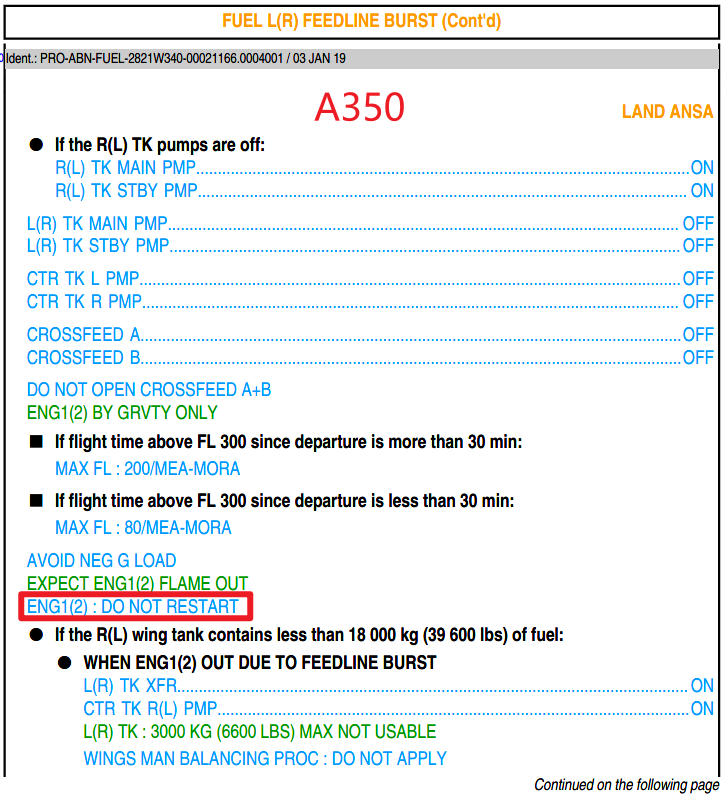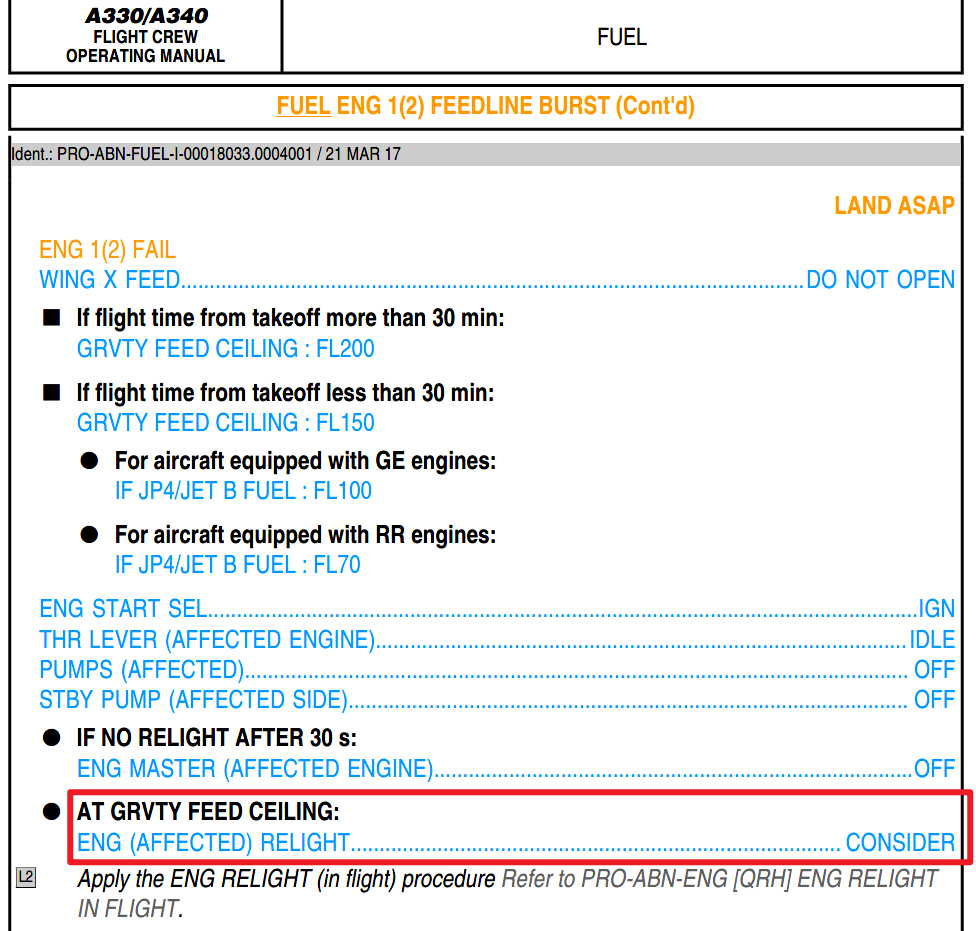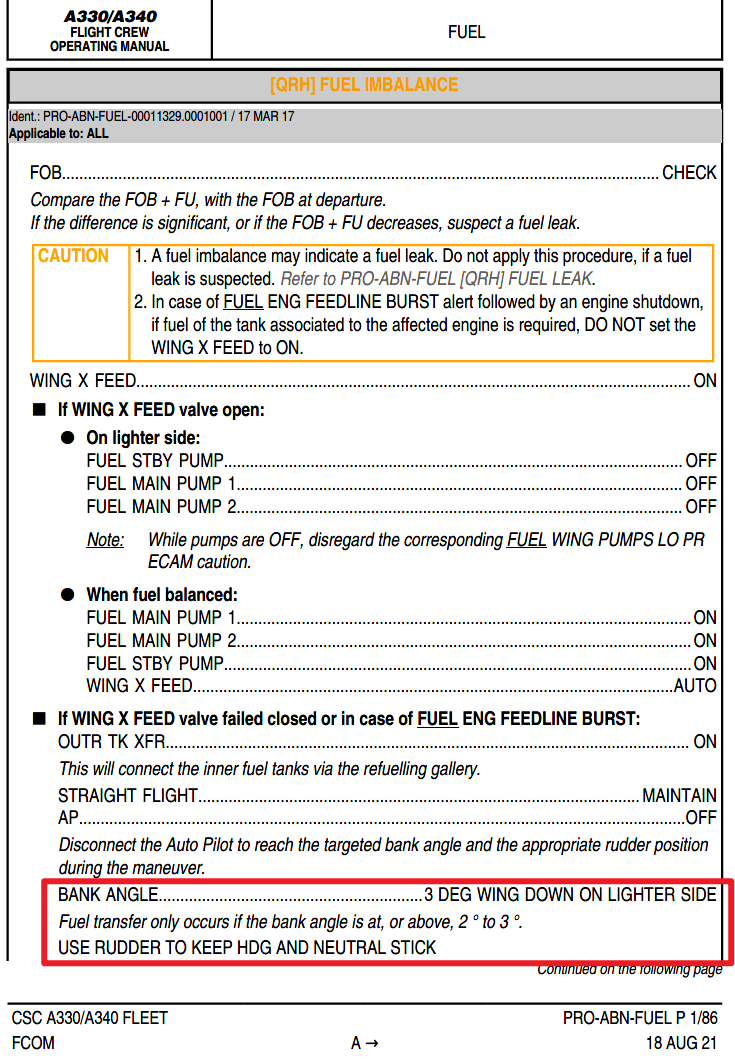由于燃油中有气泡,为了保证重力供油的稳定性,需要下降高度。而 BURST 一侧的发动机有可能在下降过程中停车,所以程序中有”EXPECT ENG1(2) FLAME OUT“字样。那么到达重力供油升限之后,能否重启发动机呢?程序里是明确禁止的,”ENG1(2) DO NOT RESTART“。
但是,在 A330 的 FUEL ENG 1(2) FEEDLINE BURST 程序中,就可以考虑重启发动机。而且也经过机务确认,他们在A330上的试验,地面使用重力供油是可以成功启动发动机的。
对于这个问题,空客回复说,A330和 A350的油箱结构不同,A330 从外侧油箱向内侧油箱重力传输比较复杂,需要飞机保持一个坡度,操作比较复杂,相比之下,重启是更方便的选择。A350可则以更容易地将机翼油箱的油重力传输到中央油箱,所以,让另一台发动机去使用则是更方便的选择。这不是一个纯的技术问题,而是技术与运行的综合考虑。所以需要注意的是,A330 也仅仅是可以考虑重启,而不是必须重启。
参考 A330 [QRH] FUEL IMBALANCE:
TechRequest 原文:
Q:
Why choose 30 min after flight time above FL 300 since departure for a threshold of MX FL? Is it ralated with cavitation of fuel? And if eng is flame out before descending to MAX FL, can we restart it after reach MAX FL?
A:
This value is defined in order to get the fuel deaerated. The air bubbles that are in the fuel require some time and pressure in order to be released out of the fuel. When this is done (after 30 minutes at FL300), there is less air that may be released out of the fuel during gravity feed when the fuel is sucked by the engine, therefore, the gravity feed ceiling is increased. This is a matter of fuel physics, this is not
directly related to A350 design.
As per ECAM procedure, the flight crew should not try to restart the affected engine.
Q_2:
I just wondering why the eng can't be restart. Is it because of gravity feeding?
A_2:
This procedure requires to feed the engine by gravity, and a flame out is expected due to the feedline burst. After flame out, the engine restart is not required as it does not enable to recover the engine (due to the feedline burst). Then the remaining fuel from the affected wing is transferred to the center tank in order to be used for the remaining engine.
Q_3:
In FUEL ENG 1(2) FEEDLINE BURST procedure of A330, there's engine relight consideration after reaching gravity feed ceiling.
And confirmed by our engineer, they've testet successfully starting engine of A330 by gravity feeding on ground.
So for A350, why can't we try to do the same? I know it maybe not able to recover, or maybe fuel leak exists. But the choice should be given to crew, we can evaluate the situation, and decide to relight or not. I think that's the meaning of "CONSIDER" (in procedure of A330).
A_3:
Many complex assumptions are taken into account for the development of the abnormal procedures. In this particular case, one objective is to maximize the amount of fuel available to the engines. Parameters such as the fuel tank and pipework geometry differs between A330 and A350, and justifies this difference.
On A350, it is preferable to transfer the fuel by gravity to the center tank compared to spending time and with attempts to restart the engine.
On A330, the gravity transfer of fuel is more complex and requires a bank angle to the aircraft, so it is preferable to consider engine relight at gravity feed ceiling.



